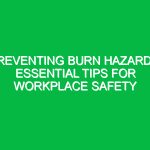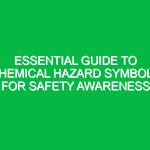Understanding Personal Protective Equipment in the HSE Context
In the context of Health, Safety, and Environment (HSE), the term personal protective equipment (PPE) refers to a range of protective gear designed to safeguard individuals from various workplace hazards. These hazards can include physical, chemical, biological, and environmental dangers that pose risks to health and safety. The use of PPE is essential in ensuring that workers remain safe and healthy while performing their duties, regardless of the industry they operate in.
The Importance of Personal Protective Equipment
Personal protective equipment plays a crucial role in mitigating risks associated with hazardous work environments. Whether you are in construction, healthcare, manufacturing, or any other sector, the right PPE can make the difference between safety and injury. Statistics reveal that the proper use of PPE can significantly reduce workplace injuries and fatalities. For instance, the Occupational Safety and Health Administration (OSHA) emphasizes that industries that prioritize PPE report lower accident rates and improved safety compliance.
Types of Personal Protective Equipment
Understanding the various types of personal protective equipment is vital for anyone involved in HSE. Here are some of the most common categories:
- Head Protection: Hard hats are a fundamental part of PPE, protecting against falling objects and head injuries. They are essential in construction sites and industrial settings.
- Eye and Face Protection: Safety goggles, face shields, and safety glasses guard against flying debris, chemical splashes, and harmful radiation.
- Hearing Protection: Earplugs and earmuffs help prevent hearing loss in environments with high noise levels.
- Respiratory Protection: Masks and respirators protect against inhaling harmful dust, fumes, and gases, especially in industries like construction and manufacturing.
- Hand Protection: Gloves protect against cuts, burns, and chemical exposure. Different materials are used depending on the specific risks involved.
- Body Protection: Protective clothing, including coveralls and vests, shields against chemicals, heat, and physical hazards.
- Foot Protection: Steel-toed boots and other safety footwear are critical in preventing foot injuries from heavy objects or hazardous surfaces.
Assessing Workplace Hazards
Before selecting personal protective equipment, it is essential to assess the specific hazards present in the workplace. This involves a thorough evaluation of the potential risks and determining the appropriate PPE required to address those risks effectively. The assessment process should include:
- Identifying potential hazards, such as chemicals, sharp objects, and falling debris.
- Evaluating the risk level associated with each hazard.
- Consulting safety data sheets (SDS) for chemical hazards.
- Involving employees in the hazard assessment process to gain insights from those directly exposed to risks.
Regulations and Standards Governing PPE
Numerous regulations and standards govern the use of personal protective equipment globally. In the United States, OSHA sets forth regulations that outline the requirements for PPE in various industries. Compliance with these regulations is not only a legal obligation but also a critical component of workplace safety culture. Other countries have their own regulatory bodies and standards. For instance, the European Union has established directives that dictate PPE requirements, ensuring that equipment meets safety and health standards.
Best Practices for Using Personal Protective Equipment
To maximize the effectiveness of personal protective equipment, organizations should adopt the following best practices:
- Training: Employees should receive comprehensive training on the correct use, maintenance, and limitations of PPE. Regular refresher courses can reinforce safety protocols.
- Fit Testing: For respiratory protection, fit testing is crucial to ensure that masks provide an adequate seal.
- Regular Inspections: Conduct routine inspections of PPE to identify wear and tear. Damaged equipment should be replaced immediately.
- Proper Storage: Store PPE in clean, dry locations to prevent contamination and damage.
- Encouragement of Reporting: Cultivate a culture where employees feel comfortable reporting issues with PPE or suggesting improvements.
Real-Life Application: Case Study
Consider a construction site where workers are exposed to multiple hazards daily. One particular project involved high-rise building construction, which presented risks such as falling tools, heavy machinery operation, and exposure to dust and debris. The site manager conducted a thorough hazard assessment and determined that the following PPE was necessary:
- Hard hats to protect against head injuries from falling objects.
- Safety goggles to shield workers’ eyes from dust and debris.
- Respirators to prevent inhalation of harmful dust particles.
- High-visibility vests to ensure workers were seen by machinery operators.
- Steel-toed boots to protect against foot injuries from heavy materials.
After implementing these measures, the site reported a significant decrease in accidents, reinforcing the importance of appropriate PPE in enhancing safety.
Challenges Associated with Personal Protective Equipment
Despite the clear benefits of personal protective equipment, challenges persist. One significant issue is the reluctance of workers to use PPE consistently. This may stem from discomfort, lack of awareness regarding the importance of safety gear, or simply forgetting to wear it. To combat these challenges, organizations can:
- Engage employees in safety discussions to emphasize the importance of PPE.
- Provide comfortable and well-fitted PPE options to encourage usage.
- Implement incentives for teams that consistently adhere to safety protocols.
Future Trends in Personal Protective Equipment
The landscape of personal protective equipment is evolving rapidly, driven by technological advancements and a growing emphasis on worker safety. Some emerging trends include:
- Smart PPE: Wearable technology that monitors health metrics and environmental conditions, alerting workers to potential hazards in real time.
- Biodegradable Materials: The development of eco-friendly PPE to reduce environmental impact while maintaining safety standards.
- Customization: Tailored PPE that fits the specific needs of individual workers or job tasks, enhancing comfort and compliance.
Conclusion
In conclusion, understanding what is personal protective equipment and its vital role in the HSE context cannot be overstated. The right PPE not only protects workers from potential hazards but also fosters a culture of safety within organizations. By assessing workplace hazards, adhering to regulations, and promoting best practices, companies can significantly reduce the risks associated with various industries. As we look to the future, embracing advancements in technology and sustainability will further enhance the effectiveness of personal protective equipment, ensuring that safety remains a top priority. It is essential for all stakeholders to recognize the importance of PPE and take proactive measures to stay safe today.


